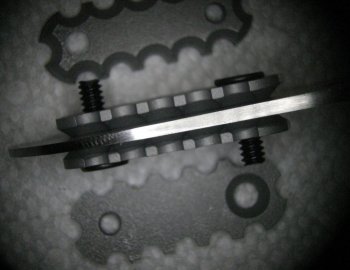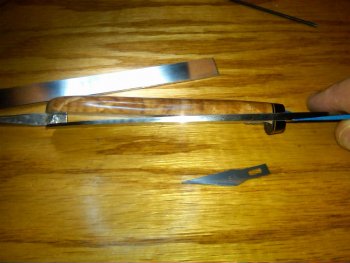Well I will say this, I am glad its you and not me!! :what!: Not being mean but this one has really got me baffled. :les:
It is hard to have more humidity than we do here in Fl. but I have never had a set of scales crawl off one,
yet, :nothing:
(knock wood)!!! I have had them to swell proud of the steel of the handle, or shrink slightly flush of the steel of the knife. If you are going back with Oak I would try a different tree, cause this one is doing some extremely weird things!! I suppose it could be the direction of the cut, or it could be the stabilization treatment or a combination of both but, I have been working with wood all my life as a carpenter and I know I have seen some strange things! However a set of scales crawling off of knife setting in a sheath that is already acclimated to the climate that it is in, and never used. That is a new one. You are getting a bond from looking at the pics, and if it is not from use, process of elimination says it is the scales!!
Seriously satisfying the wants of your client is always utmost of importance! However years of construction experience allowed me into insight of some areas I draw the line. With construction it was, "is it against the codes or dangerous, or do I know from my own experience that won't work"!
Usually that is an assessment made at the beginning!
If a clients want to use a specific material on a project and I know from experience it will never work. Then you have to put your foot down and say
NO, it will never stay I have done it before and I won't use that material because, it is not going to stand up to the conditions it will be exposed to and therefore,
I can not guarantee my work.
That philosophy has cost me some jobs in the past. However when the client came back after getting someone else to do what I refused to do, and confessed it did come apart, just like I said it would. Well it is reeeeeeeeeeeal hard not to say,
"I told you so", but that don't make for good business!!!! :biggrin:
In this case getting him what he wants is going to require he give a little or some thought on your part!
If I am understanding you correctly you are going to embed these fasteners in the backside of the scales. I
may not be getting what you are saying!!!
Is that correct, they are to be embedded in the scale??
If that is correct, how are you going to tighten the screw without the screw either being exposed or at the least drilling a hole and then plugging it???
I am getting in the court with ED, on trying some other material W/fasteners ( I mentioned that earlier) but, you will have to get the client to agree with that one. I would lay it out to him because like others have mentioned you are going to loose this client and he going to talk bad about your product.
Tell him I will replace this once again but this time w/fasteners and/or a different material. He obviously likes the knife. So tell him flat out the strain that carving is putting on the knife is causing the knife to flex, (which is what is supposed to do) but, that strain is going to rip apart any material I put on this knife handle without some kind of fastener. Remind him that you have always done him right in the past and there is no reason to lead him astray this time!!
Good luck!


